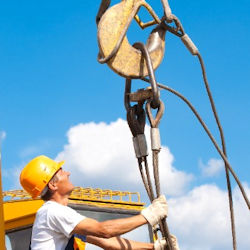SECTION 15 - RIGGING
15.A General.
15.A.01 Inspection and use.
- Rigging equipment must be inspected as specified by the manufacturer, by a Competent Person (CP), before use on each shift as necessary during its use to ensure that it is safe. The CP must have training and experience equivalent to, or be under the supervision of a Qualified Rigger (QR) as defined in Appendix Q.
- Defective rigging must be removed from service.
- The use, inspection and maintenance of rigging equipment must be in accordance with the rigging equipment manufacturer.
- Rigging equipment must not be loaded in excess of its working load limit (WLL).
- Rigging equipment, when not in use, must be removed from the immediate work area and properly stored and maintained in a safe condition.
15.A.02 Hoist rope must not be wrapped around the load.
15.A.03 All eye splices must be made in an approved manner per ASME B30.9.
15.A.04 When hoisting loads, a positive latching device must be used to secure the load and rigging (e.g., self-closing or self-locking hooks, an alloy anchor type shackle with a bolt, nut and retaining pin, screw-pin shackle, etc). > See Section 15.E.07.
15.A.05 Custom fabricated grabs, hooks, clamps, or other lifting accessories (e.g., equalizing beams, lifting or spreader beams, etc.) for such units as modular panels, prefabricated structures, and similar materials must be designed by an Registered Professional Engineer (RPE), marked to indicate the WLL and must be proof-tested before initial use, to 125% of their WLL.
15.A.06 Structural and mechanical lifting devices must be designed, tested and used in accordance with ASME B30.20, Below the Hook Lifting Devices.
Knowledge Check Choose the best answer for the question.
15-1. When hoisting loads, what is required to secure the load and rigging?
You forgot to answer the question!

